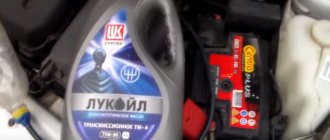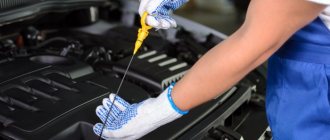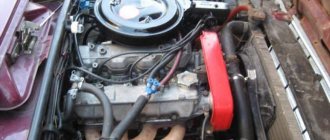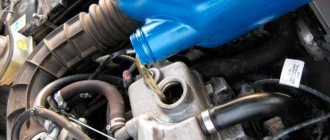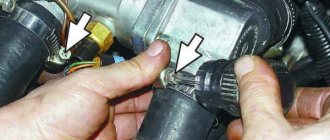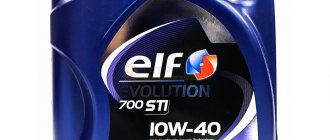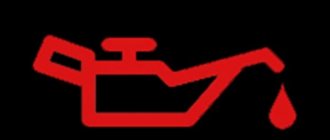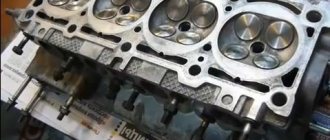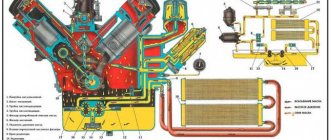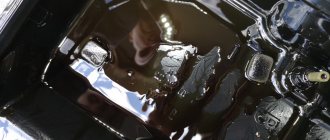When to clean the engine
Flushing the engine with kerosene before replacing should not be done every time, as many service stations recommend, hoping to earn more money from you. The need for cleaning is determined based on the vehicle's mileage. As a rule, it is recommended to clean the engine every 70-80 thousand mileage. But in fact, no one does this, so to make control easier, we’ll set the bar at 100 thousand mileage. During this time, the surface and insides of the parts become overgrown with smudges and smoke, which must be removed, because all this reduces the power of the engine and affects its operation.
When is engine flushing not necessary?
There is no need to flush the engine in the following cases:
New car . You bought a car from a dealership and want to start using it. If the car is under warranty and you have a document confirming this, there is no need for you to take the initiative and wash anything anywhere. This, as they say, is a “headache” for the service station that will perform after-sales service. In your case, the most important thing is to clearly monitor the quality of work performed, as well as the schedule, so as not to accidentally miss scheduled maintenance.
Regular oil changes . If you do a routine engine oil change, you don't need to flush the engine every time, just change the oil and oil filter regularly. If you really want to, you can wash it every 10th replacement, for example, or more often, it all depends on a large number of factors.
What cleaning methods are there?
Flushing the engine with kerosene before changing the oil can be done in other ways, more gentle and faster. Gentle cleaning is a more suitable option, because it does not cause any harm to the car. This is a fairly common cleansing practice. A special cleaning liquid is poured into the engine block and left there for a while, and with this liquid the car must cover 150-200 km.
Flushing the engine before changing the oil, a video of which you can view in the article, can be done periodically.
When the car has covered the required distance, it is returned to the service center, where the liquid is already drained, and along with it all the fumes and pieces of burnt material come out. As a result, the motor will work better and quieter, reception will be normalized and without interruptions, and elasticity will increase. With this procedure, it is also recommended to install new filters.
REPLACEMENT
Replacing the cooling radiator on a VAZ is very simple:
- Remove the expansion tank plug;
- Drain the antifreeze from the radiator and cylinder block. It is necessary to prepare a container for liquid in advance;
- We dismantle the air filter housing, it will interfere with removing the radiator;
- Disconnect the electric fan plug, unscrew the two bolts securing it and dismantle the unit;
- We loosen the clamps where it is more convenient and pull off the pipes;
- In the upper part of the radiator, remove the two bolts securing it to the body frame, tilt its body towards the engine and remove the part. Radiator removal is complete;
- We reassemble in the reverse order, then fill in antifreeze and start the engine.
How to quickly get the job done
Flushing the engine before changing the oil, a video of which will help you become more familiar with the technology, can be done using the express method.
It is carried out according to the same principle. A cleaning agent is poured into the block, but now the car only needs to drive for 15-20 minutes before the liquid can be washed off. The aggressive substance, which is poured into the block, cleans the metal and all elements well under the influence of high temperature. Of course, many will say why careful cleaning is needed to take the car to the service center twice, if everything can be done in one day.
The fact is that the quick cleaning solution has a strong effect on the metal, increases its wear, and if you do this cleaning 3 times in a row, it can lead to deformation of small elements. Flushing the engine with diesel fuel before changing the oil, a video of which will allow you to understand how to eliminate mistakes, can be done by you yourself.
How often is this done?
Dirty motor
There are no clear recommendations here, since engine contamination is influenced by many factors.
- Many experts advise washing the engine of a VAZ 2114 approximately once every 2 years. Is it a lot or a little? It all depends on the operating conditions, the condition of the engine itself, the presence of oil leaks, and so on. A faulty or problematic engine will quickly become dirty. But what is better to do in this case - wash it regularly or eliminate the reasons why oil marks appear on the engine every now and then? The answer is obvious - VAZ 2114 repair.
- There is also a completely understandable opinion according to which it is recommended to wash the engine before the start of each new season, that is, approximately during the transition from summer tires to winter tires and vice versa.
- You shouldn’t get too carried away with this, since careless washing can only harm the engine, and its excessive contact with water can lead to even more serious problems than oil stains.
Article on the topic: The oxygen sensor on the VAZ 2114 gives errors: we clean the lambda probe with our own hands
When work is necessary
Quite often, car owners wonder when there is a need to carry out the work described in the article. This need may arise if you are planning to switch from one brand of motor oil to another. This can be attributed to their types of fuels and lubricants, since among them there are mineral, synthetic and semi-synthetic. Each of them may have a certain viscosity, and may also be manufactured by a different manufacturer. Each composition has its own unique additives, which should not be mixed with each other. If you purchased a car that was previously in use and do not know what fuels and lubricants the owner used, then it is best to carry out the work described, this will allow you to start the life of the engine from scratch.
General recommendations
In each case of engine flushing, which are described above, it is necessary to monitor the oil pressure. First of all, this applies to supercharged engines and diesel engines, for which a lack of lubrication is critical and unacceptable.
Car enthusiast companies say that flushing internal combustion engines with diesel fuel is very effective and economical. For these purposes, people use both pure diesel fuel and a mixture with motor oil in a 1 to 1 ratio.
Experts, answering the question of what is the best way to flush a diesel engine, suggest one of the methods described above. In addition, it should be understood that solarium is capable of destroying various rubber seals and structural elements.
Source
Positive effect and possible negative consequences
Diesel fuel has excellent dispersing ability. That is, it dissolves even old deposits of various natures, including sludge. Therefore, many motorists 20-30 years ago actively used diesel fuel as a liquid for flushing engines. That is, in those days when engine parts were massive with an impressive margin of safety and minimal requirements for fuels and lubricants.
In addition, some diesel fuel, which will certainly remain in the engine crankcase, will not have a pronounced negative effect on the new oil. After flushing the engine with diesel fuel, it is not necessary to somehow expel the remaining diesel fuel from the crankcase or to fill and drain fresh oil several times.
This method of cleaning the motor is also relatively inexpensive. Compared with cleaning agents, and even more so with specialized oils, washing the engine with diesel fuel will be several times cheaper.
This is where the positive aspects of this procedure end. Let's briefly look at the possible negative consequences.
- Lumpy detachment of solid deposits. Sludge build-up accumulates on static surfaces in many motors. Diesel oil can simply separate them from the surface and dump them into a pan. Or run it into the oil channel. Which will cause partial or complete blockage and oil starvation of any friction pair.
- Negative impact on rubber (caoutchouc) and plastic parts. The vast majority of modern seals and retainers in engines made of plastic and rubber are resistant to the chemical effects of any petroleum products. But diesel fuel can completely destroy “tired” non-metallic parts.
- Possible damage to the liners and the formation of scuffing in the ring-cylinder friction pairs. Diesel fuel does not have sufficient viscosity to create any strong protective layer.
All these consequences have the status of probable. And they will not necessarily occur in every individual case.
How to clean engine oil
When choosing a product for cleaning engine oil, it is necessary to proceed from the fact that this substance should have minimal negative effects on fresh engine oil.
The active components and additives of the latter are capable of reacting with various flushing ingredients, causing a decrease in viscosity and foaming of the lubricant.
All this affects the performance characteristics of the oil, which can significantly “sag”, which ultimately will negatively affect the performance and service life of the power unit.
In what cases should you absolutely not wash your engine with diesel fuel?
There are two cases in which flushing the engine with diesel fuel before changing the oil is more likely to have a negative rather than a positive effect.
- A very tired engine with a lot of output. It is not without reason that some car operating instructions say that after a certain operating time (when the engine wears out and all the gaps in it increase), it is advisable to start filling in thicker oil. This is done to compensate for gaps due to the thicker and more durable oil film created by thick oil. Diesel fuel has a very low viscosity. And even with its short-term use, metal-to-metal contact in all loaded friction pairs will be irreversible. The result is accelerated wear to the limit and a high probability of jamming.
- Modern technological engines. There is no question of using regular oil with the wrong viscosity. And using diesel fuel as a flush at a minimum (even with a single fill) will significantly reduce the service life of the motor.
Reviews from motorists who have tried the diesel fuel flushing method
Good reviews about the method of washing an engine with diesel fuel are mainly left by owners of outdated equipment. For example, drivers often wash ZMZ and VAZ engines with diesel fuel. Here, in most cases, there are no pronounced negative consequences. Although it is not a fact that in one wash the car owner did not reduce the engine life of thousands by 50 km.
You can also find negative reviews on the Internet. For example, after filling with diesel fuel, the engine seized. After disassembly, worn out and twisted liners were discovered.
Therefore, the conclusion about this method of cleaning the engine is this: you can use diesel fuel, but carefully and only on well-preserved outdated engines.
Flushing the engine with diesel fuel before changing the oil is an old, but reliable and simple way to clean the power unit.
Today, many drivers laugh at the “eccentrics” who use this washing method. Diesel oil makes it possible to remove dirt and carbon deposits without the use of aggressive additives.
You don’t have to worry about engine parts that can be damaged by aggressive influences. By flushing the engine with diesel fuel, it is possible to simply, inexpensively and safely extend the service life of the engine.
When is rinsing necessary?
When a vehicle is used, resin accumulates in the lubricating system of its internal combustion engine. Carbon deposits appear on the walls of oil channels, which can significantly impair oil circulation and reduce cooling efficiency. The situation is aggravated by pouring low-quality oil fluid.
All highways may become clogged. Every ten to fifteen thousand kilometers the car oil is changed. However, if the car was operated in harsh conditions with poor lubrication, then filling with fresh petroleum product will be pointless without cleaning the gasoline/diesel internal combustion engine.
It is necessary to flush the engine with diesel fuel before replacing the lubricant in the following situations:
- switching to a different type of motor oil;
- pouring lubricant into a newly purchased car (provided that you do not know the brand of oil that was previously filled);
- penetration of coolant or fuel into the oil liquid;
- completion of a complete overhaul of the power unit.
Features of the washing procedure
The main reason for washing the engine with diesel fuel is to completely cleanse the internal combustion engine of past lubricant and contaminants. Often, liquids are used for cleaning that can dissolve solids, resin and old oil residues. Usually, special additives are added to the car oil before draining.
You can also fill in the flushing agent after draining the used consumables. Today's flushes perform their task well, but they are expensive and considered quite aggressive. If they are added to the engine, they can destroy its parts.
The best flush for the engine cooling system
Flushing with water is well suited for the internal combustion engine cooling system. This method allows you to solve the problem quickly and at minimal cost.
It is recommended to use distilled water as it does not contain any aggressive substances that can damage rubber parts. This method is effective only in cases where the contamination is negligible.
The use of acids is more effective. This option involves the use of citric or phosphoric acid, which are diluted in distilled water in a proportion of 100 g per 1 liter.
Liquid poured into the cooling system remains there for at least three quarters of an hour. This procedure should be preceded by flushing with plain water, which is repeated after draining the acid from the system. The final rinse with water involves 4-5 full cycles to completely neutralize the acidic environment.
Car enthusiasts often resort to washing with a bite. In this case, an aqueous solution is formed in a proportion of 1 to 10. In order for the cleaning agent to function well, after pouring the solution into its system, it is heated to approximately 100 degrees Celsius.
After this, it is left in the system for about 10 hours. If, when draining the solution, there is no dirt and/or scale in it, then there was not enough time and the procedure should be repeated.
Washing with soda also finds its use, but exclusively for cleaning engine elements made of copper and/or brass. For these purposes, 50 grams of soda are diluted in a liter of plain water. This composition is cheap, but does the job perfectly.
How is flushing performed?
The engine is washed with diesel after draining the old motor oil. Draining is performed as standard, through a hole in the crankcase pan.
- Place your car on an inspection ditch or a special overpass.
- Using a special tool, loosen the drain cap.
- Place a pre-prepared container under the drain.
- Remove the cover by sharply pulling it to the side. This is necessary so that the stream of oil is directed exactly into the container.
- Wait until all the consumables have been drained.
- Remove the car oil filter. This is usually done manually, but if necessary, you can use a key.
- Install a temporary oil filter. It is only necessary for the engine flushing procedure, so it is advisable to purchase the most inexpensive product.
- Quickly pour diesel into the internal combustion engine (you can mix it with lubricant or use kerosene). Three liters will be enough. The initial impulse of the filling jet is needed so that the diesel fuel spreads throughout the entire power unit. The diesel will pass through the lubricating complex and flow out of the drain. This will eliminate the most serious contaminants and waste oil residues.
- Close the oil pan drain cover.
- Pour diesel into the internal combustion engine. Pour as much diesel fuel as you usually pour lubricant.
- Run the engine for a short time to run it in boost mode.
- Make sure that the internal combustion engine does not reach operating temperature.
- Turn off the motor.
- Remove the drain cover.
- Drain the diesel engine. If you notice that dirt particles come out along with the last drops of diesel fuel, repeat the rinsing.
- When clean diesel fuel starts flowing from the drain, close the lid.
- Remove the temporary oil filter.
- Install a new oil filter for further operation of the vehicle.
- Fill with fresh oil.
- Check the power unit for leaks.
If you did everything correctly, then the washing can be considered complete.
